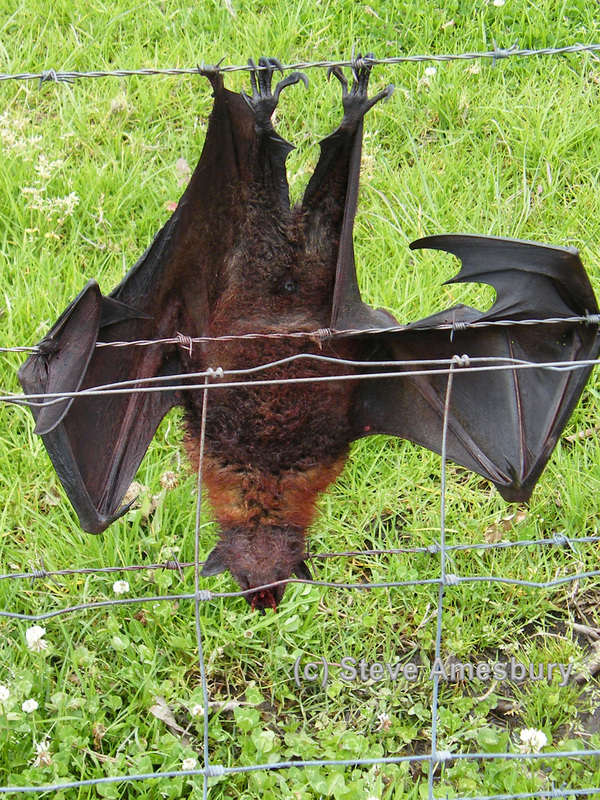About Queensland's Flying-foxes
Queenslanders are blessed to live in a diverse natural environment with exciting wildlife. Flying-foxes offer some of our greatest wildlife spectacles and have a fascinating natural history. They also have a vital ecological role in pollinating and dispersing the seeds of many native trees. But they are subject to persecution, continue to lose important habitat, and face an uncertain future.
A viable future for our ‘finger-winged night-workers’ (as poet Les Murray describes them) depends on support and action by Queenslanders to protect them from multiple threats. As the Queensland Government says, “The survival of flying-foxes depends on our ability to live with them.”[1]
A viable future for our ‘finger-winged night-workers’ (as poet Les Murray describes them) depends on support and action by Queenslanders to protect them from multiple threats. As the Queensland Government says, “The survival of flying-foxes depends on our ability to live with them.”[1]
|
Our flying-fox species
Flying-foxes are large bats (megabats). They differ from microbats (little bats) by feeding on nectar and fruit, not insects, and navigating by vision rather than echolocation. They roost in large groups on tree branches, rather than in caves or hollows. Four species of flying-fox inhabit mainland Australia and all four live in Queensland (there are also island species). Grey-headed flying-foxes live in eastern Australia from Mackay to Geelong, and recently also in Adelaide. Spectacled flying foxes live in tropical north Queensland. Black flying-foxes occur across northern Australia and along the east coast down to Sydney. Little red flying-foxes have the largest range, in western, northern and eastern Australia in coastal and inland areas Legal status As native mammals, all flying-foxes are protected in Queensland and cannot be harmed or killed unless a permit is issued by the Queensland Government (under the Nature Conservation Act 1992). The Spectacled flying-fox and Grey-headed flying-fox are also protected under federal laws (the Environmental Protection and Biodiversity Conservation Act 1999) as threatened species. They were listed as ‘vulnerable’ in 2002 after substantial population declines due to habitat destruction, large-scale slaughter and other threats. It is only very recently - since 1994 and from 1974-1985 - that flying-foxes have received any protection under law. For most of Queensland’s history as a colony and state, flying-foxes were classed as vermin and there were no limits on killing. They were subject to large-scale slaughter, with shooting raids on camps and a bounty in many districts to encourage extermination. Flying foresters (also see our conservation page) Flying-foxes play a very important ecological role by pollinating and dispersing the seeds of many native plants. They are long-range pollinators, promoting genetic flow between eucalypts and other Myrtaceae at greater distances apart (> 5 km) than most other pollinators.[2] Spectacled flying-foxes feed on the fruit of more than a dozen rainforest species for which no other seed dispersers are known and can spread ingested seeds up to 80 km away.[3] Such long-range capacity for spreading pollen and seeds is very important to genetically re-link habitats fragmented by clearing. It will also be vital in assisting native plants to adapt to climate change. Long before flying-fox species are recognised as threatened, they may become functionally extinct, as populations decline below the threshold necessary to contribute significantly to seed dispersal and pollination.[4]
Threats (also see our conservation page) Flying-foxes are subject to a multitude of threats: ongoing habitat loss from urban and agricultural expansion, illegal killing, camp destruction and harrassment, heat stress, tick paralysis, entanglement in barbed wire and loose backyard netting, and electrocution on powerlines (see pictures below).
Because of low reproductive rates, flying-foxes are vulnerable to population declines. With females able to bear only one young a year and generally not reproducing until they are 3 years old, they have a low capacity for population increase. It is biologically impossible for flying-foxes to build up to “plague” numbers. Population stability requires high survival rates of adults and juveniles. An imposed mortality as low as 10% in addition to natural mortality can lead to rapid decline of a large population.[6] The future belongs to bats too! |
REFERENCES:
[1] http://www.derm.qld.gov.au/wildlife-ecosystems/wildlife/living_with_wildlife/flyingfoxes/living-with-flying-foxes.html.
[2] Eby, P. (1996) Interactions between the Grey-headed Flying-fox Pteropus poliocephalus (Chiroptera: Pteropodidae) and its diet plants - seasonal movements and seed dispersal. PhD Thesis, University of New England, Armidale, NSW.
Birt, P. (2005) Mutualistic interactions between the nectar-feeding little red flying fox Pteropus scapulatus (Chiroptera: Pteropodidae) and eucalypts: habitat utilisation and pollination. PhD thesis. University of Queensland, Brisbane.
[3] Westcott, unpublished data, cited in Queensland Department of Environment and Resource Management (2009) National recovery plan for the spectacled flying fox Pteropus conspicillatus. Report to the Department of the Environment, Water, Heritage and the Arts, Canberra.
[4] McConkey K, Drake D. (2006) Flying foxes cease to function as seed dispersers long before they become rare. Ecology 87(2): 271-76..
[5] Australasian Bat Society and Queensland Government. Living with Flying-foxes.
[6] McIlwee A, Martin L. (2002). On the intrinsic capacity for increase of Australian flying-foxes. (Pteropus spp., Megachiroptera). Australian Zoologist. 32: 76-100
[1] http://www.derm.qld.gov.au/wildlife-ecosystems/wildlife/living_with_wildlife/flyingfoxes/living-with-flying-foxes.html.
[2] Eby, P. (1996) Interactions between the Grey-headed Flying-fox Pteropus poliocephalus (Chiroptera: Pteropodidae) and its diet plants - seasonal movements and seed dispersal. PhD Thesis, University of New England, Armidale, NSW.
Birt, P. (2005) Mutualistic interactions between the nectar-feeding little red flying fox Pteropus scapulatus (Chiroptera: Pteropodidae) and eucalypts: habitat utilisation and pollination. PhD thesis. University of Queensland, Brisbane.
[3] Westcott, unpublished data, cited in Queensland Department of Environment and Resource Management (2009) National recovery plan for the spectacled flying fox Pteropus conspicillatus. Report to the Department of the Environment, Water, Heritage and the Arts, Canberra.
[4] McConkey K, Drake D. (2006) Flying foxes cease to function as seed dispersers long before they become rare. Ecology 87(2): 271-76..
[5] Australasian Bat Society and Queensland Government. Living with Flying-foxes.
[6] McIlwee A, Martin L. (2002). On the intrinsic capacity for increase of Australian flying-foxes. (Pteropus spp., Megachiroptera). Australian Zoologist. 32: 76-100










